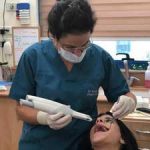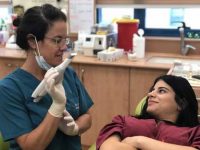Intraoral scanner – what is it all about? In the past every dentist worldwide used sticky paste materials to make an impression of the teeth. This way the information was transferred to a dental lab.
 In order harden, the impression material has to stay in the mouth for about 3 minutes. And please, make no mistake – 3 min is a lot of time with a mouthful of sticky mass! This technique caused a lot of inconvenience and even nausea to the patients with a sensitive palate, so called Gag reflex.
In order harden, the impression material has to stay in the mouth for about 3 minutes. And please, make no mistake – 3 min is a lot of time with a mouthful of sticky mass! This technique caused a lot of inconvenience and even nausea to the patients with a sensitive palate, so called Gag reflex.
Recently in our dental clinic in Beer Sheva we replaced the impressions by a digital imaging of the teeth and the mouth tissues. Tiny intra-oral camera moves around the mouth and scans whatever needs to be recorded. The program stiches thousands of individual snapshots to a 3D simulation. All we have to do is to push the button. The computer transfers the data instantaneously to a lab anywhere on planet Earth.
Currently we use labs in Tel Aviv, Beer Sheva, Dusseldorf (Germany) and Hong Kong (China) .
What do we take scans for in our clinic using our Trios 3 intraoral scanner :
- Invisible clear aligners for orthodontics
- Porcelain crowns, Zirconia crowns
- Inlays and Onlays ( porcelain cavity fillings )
- Laminates
- Computerized implant planning
- Implant supported restorations, dentures and bridges
- All on 4, all on 6 restorations
 We transfer the scans to the chosen lab, faster, cleaner and most important – no infection spread within impression material . Precise measurments, no remakes, no nausea .
We transfer the scans to the chosen lab, faster, cleaner and most important – no infection spread within impression material . Precise measurments, no remakes, no nausea .
Better comunication with the lab, speedy and accurate fabrication.
What are the benefits of the intraoral scanner in our dental clinic in Beer Sheva:
- No gag reflex or nausea
- No repeat impressions or remakes
- More accuracy and precision
- Less appointments – patients and dentists time savings
- Faster production and shipping
- Ability to work with any lab, anywhere in the world, according to labs expertise